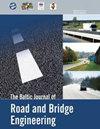Behaviour of a Space Inverted Triangular Steel Truss
IF 1.1
4区 工程技术
Q4 ENGINEERING, CIVIL
引用次数: 1
Abstract
Behaviour of the inverted triangular truss, which is widely used as a bridge girder, was investigated analytically and experimentally. Cold-formed square hollow cross-sections of steel grade S355J2H with dimensions 80 mm × 4 mm, 90 mm × 4 mm and 40 mm × 4 mm were selected for the top and bottom chords and bracing elements of the truss with 12.56 m span, correspondingly. Five FEM models were developed using software Dlubal RFEM. The main specific feature of the models is the difference in modelling of joint behaviour considering plastic behaviour and stiffness of truss connections. It was shown that the FE model of the truss where the members were modelled by the truss type finite elements and the joints modelled by the shell type ones allows predicting behaviour of the truss with precision of up to 3.9%. It was shown that precision of the suggested FEM model grows 4.36 to 4.62 times in comparison with the traditional FEM models where the members were modelled by the truss finite elements with the pinned and rigid joints in case of plastic joint behaviour. Precision of the suggested FEM model is identical to that of the traditional FEM models regarding the case of elastic joint behaviour.空间倒三角钢特拉斯的性能
对广泛应用于桥梁的倒三角特拉斯的受力性能进行了分析和试验研究。跨度为12.56m的特拉斯上弦杆、下弦杆和支撑构件分别选用尺寸为80mm×4mm、90mm×4mm和40mm×4mm的S355J2H钢冷成型方形空心截面。使用Dlubal RFEM软件开发了五个有限元模型。模型的主要特征是,考虑到特拉斯连接的塑性行为和刚度,节点行为建模存在差异。结果表明,特拉斯的有限元模型(构件采用特拉斯型有限元建模,节点采用壳型有限元模型建模)允许预测特拉斯的性能,精度高达3.9%。结果表明,与传统的有限元模型(构件采用特拉斯建模)相比,所建议的有限元模式的精度提高了4.36至4.62倍在塑性接头行为的情况下,具有销接和刚性接头的有限元。在弹性接头行为的情况下,所提出的有限元模型的精度与传统有限元模型相同。
本文章由计算机程序翻译,如有差异,请以英文原文为准。
求助全文
约1分钟内获得全文
求助全文
来源期刊
CiteScore
2.10
自引率
9.10%
发文量
25
审稿时长
>12 weeks
期刊介绍:
THE JOURNAL IS DESIGNED FOR PUBLISHING PAPERS CONCERNING THE FOLLOWING AREAS OF RESEARCH:
road and bridge research and design,
road construction materials and technologies,
bridge construction materials and technologies,
road and bridge repair,
road and bridge maintenance,
traffic safety,
road and bridge information technologies,
environmental issues,
road climatology,
low-volume roads,
normative documentation,
quality management and assurance,
road infrastructure and its assessment,
asset management,
road and bridge construction financing,
specialist pre-service and in-service training;

 求助内容:
求助内容: 应助结果提醒方式:
应助结果提醒方式:


